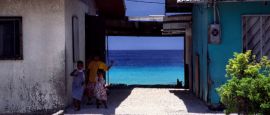Marshall Islands History, Language and Culture
History of Marshall Islands
The Marshall Islands were first sighted by European explorers, including Magellan, in the early 1500s. Portuguese and Spanish influences prevailed until the middle of the 19th century, when German trading interests brought the islands and its indigenous inhabitants under German colonial control. In 1914, upon the outbreak of World War I, the islands were occupied by the Japanese; their takeover was recognised in 1920, by a 'mandate to administer' issued by the League of Nations (forerunner of the United Nations). Several large military bases were built and Japan claimed the islands as a colony in 1938. The islands were then captured by US forces, during the course of the World War II Pacific campaign, in 1944. In 1947 the Marshall Islands were incorporated by the United Nations into its Trust Territory of the Pacific Islands and placed under US administration initially the US Navy, then from 1951, a civilian administration. Like the Japanese before them, the US used the islands as a strategic military base, training area and ultimately as a nuclear test site. Nuclear testing became a major political issue over the following decades. From the mid-1960s, the islanders became increasingly assertive, adopting the Congress for Micronesia as the main focus for debate and dissent. Note was elected again for a second term in November 2003.
During the 1970s, the gradual process of dismantling the Trust Territory of the Pacific Islands Palau, the Northern Marianas, the Federated States of Micronesia, and the Marshalls began, as internal self-government was granted and negotiations on full independence got underway. In 1983, the Marshall Islands assembly (the Nitijela) agreed the Compact of Free Association with the US government, which set down the terms under which the Marshall Islands would become a sovereign self-governing nation. The USA retained responsibility for the defence and security of the islands, also setting down guidelines for the conduct of the Marshalls' future foreign policy. US$30 million annual aid has been provided by Washington, in exchange for the continued use of existing military bases. (The original 15-year period covering that part of the agreement was extended. A new Compact came into force in September 2003). The Marshalls now belong to the South Pacific Forum, the main regional grouping, and in 1991 were admitted to the UN.
Until his death in 1996, Amata Kabua who was elected to five consecutive terms as president from 1979 was the dominant political figure on the atoll after independence. The main issues facing successive governments have been the legacy of the nuclear testing and the state of the economy. Extensive nuclear testing, especially on the Kwajalein Atoll, has resulted in long-term damage to islanders' health and to the environment. The extent and nature of compensation and restitution in the form of environmental improvement and healthcare remain sore points in relations between the Marshalls and the USA. Following the death of Amata Kabua, his cousin, Imata Kabua, was elected as his successor in January 1997. Imata Kabua's government was undermined by allegations of corruption and following elections held at the end of 1999 he was replaced by Kessai Note, who leads a bloc associated with the United Democratic Party, although officially no political parties are represented in the Nitijela.




 You know where
You know where